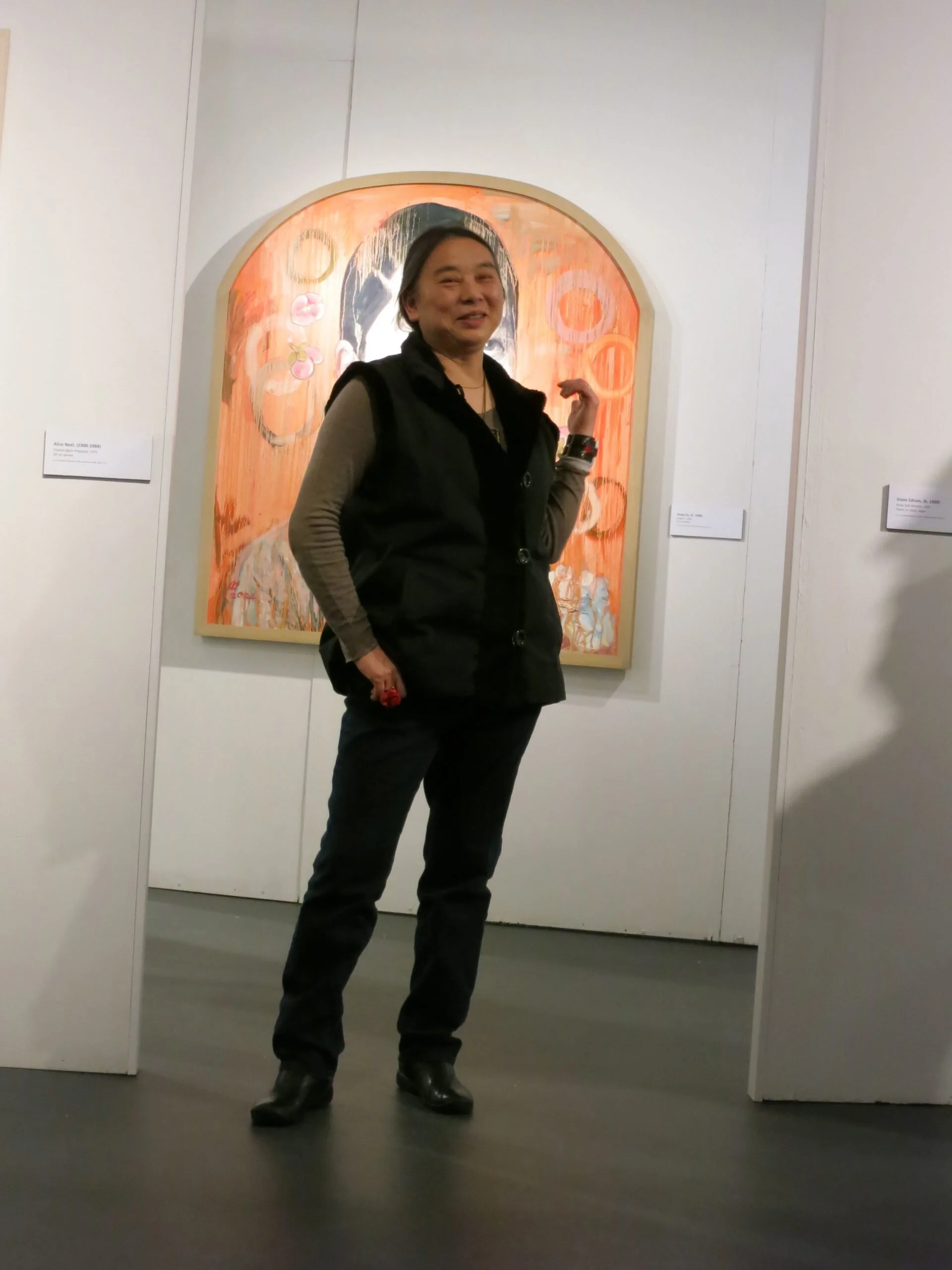Reflection of Hung Liu
1948-2021
By Deborah Howard, Painting Professor at the University of Denver
Hung Liu is one of the most significant painters to come out of the 21st century. Her work has been exhibited throughout the world and currently, there is a retrospective at the National Portrait Gallery in Washington DC titled Hung Liu: Portraits of a Promised Land; this is the most comprehensive exhibition of her work on the east coast and the last one in her lifetime.
Apsaras depicts a wailing old woman who was in the 2008 Sichuan Earthquake that killed 90,000 people including thousands of school children whose shoddily constructed classrooms collapsed. Hung was in Beijing at the time of the 8.0 quake. Over the old woman’s face are painted flying Chinese Buddhist angels called apsaras.
Hung was born in Changchun, China in 1948. Her father was in Chiang Kai-shek’s Nationalist Army and captured by the Communists and imprisoned. Hung and her mother fled to Beijing and survived Mao Zedong’s Great Leap Forward that caused mass famine. Hung’s mother destroyed all family photos, including Hung’s father, to protect her from the Mao regime that viewed Nationalists and their families as enemies of the people. Hung treasured family photographs, whether they were her own family or someone else’s.
At 20, Hung was sent to the countryside for proletarian re-education and spent four years working every day in the fields with China’s poorest people. Later, Hung attended the Central Academy of Art in Beijing and waited seven years for the Chinese government to approve her passport to attend graduate school at the University of California in San Diego. In 1984, Hung arrived in the US with one suitcase and twenty dollars, and received an MFA in 1986, and taught painting at Mills College in Oakland, CA.
Hung’s paintings are masterful, empathetic, beautiful, and transcendent. They are also politically powerful. She worked from old photographs found in Chinese flea markets depicting prostitutes, children, peasants, and the brutality of the cultural revolution. Paintings done in the latter part of her life were about America and based on Dorthea Lange’s photographs of migrant families during the Depression. Hung regarded Lange as a personal hero. Hung’s paintings are known for their drips which she called Weeping Realism. National Portrait Gallery curator Dorothy Moss stated Hung’s paintings “honor the stories of those who are at risk of being forgotten.”
Hung had a relationship with DU’s School of Art & Art History, and her work was shown numerous times in the Vicki Myhren Gallery. I met Hung in 2014 when she was a visiting artist where she met with students and lectured. In Hung’s lecture, she told the story of seeing Robert Rauschenberg at the Venice Biennale and asked him to sign her passport, and said it became her “passport to the artworld.” While Hung was here, I asked her to sign my high school passport that I used when I was going to Israel to work on a communist farm. I told Hung I freely went to the farm around the same time she was sent to labor in the countryside. I own the painting Apsaras because she asked to trade a painting of mine of a gold shoe.
Hung became a mentor late in my academic career when I already had taught painting for more than 20 years. All artists need mentors and teachers at any point in their lives. Hung was supportive of my work especially my Project: Portraits of Child Survivors of the Holocaust. Hung had a great sense of humor and during the Pandemic and the Election, emailed me funny and hopeful videos. My last text from Hung was the cover of a New Yorker magazine depicting an eagle with Trump dangling from its beak, her text read DUMP TRUMP!
“The story of America as a destination for the homeless and hungry of the world is not only a myth. It is a story of desperation, of sadness, of uncertainty, of leaving your home. It is also a story of determination, and — more than anything — of hope. ”
Hung Liu was a teacher and mentor to many people because she had a way of connecting and understanding people. She deeply felt their sadness and their joy and loved to laugh. In October 2020, Hung zoomed with my painting workshop from her studio in Oakland, CA. She was so excited to talk to each student and showed us the new paintings going to the Portrait Gallery and invited us to the reception.
Hung passed away August 7, 2021, two weeks before the opening of Portraits of a Promised Land at the Portrait Gallery. However, before she died, curator Dorothy Moss went to see Hung and showed her photographs of the exhibition that had already been installed. Hung faced life, art, and death with courage, perseverance, and dignity.
The above transcript is in full. An excerpted version is displayed alongside the painting Asparas in the exhibition, Portrayal: Figurative Art from the Madden and University Art Collections.
Hung Liu in front of her painting in the “The Female Gaze” exhibition at the Vicki Myhren Gallery, University of Denver, 2014
Howard’s passport signed by Hung Liu, “For Deborah, For our shared memories of revolution, art, and life. April 13, 2014, Denver”

